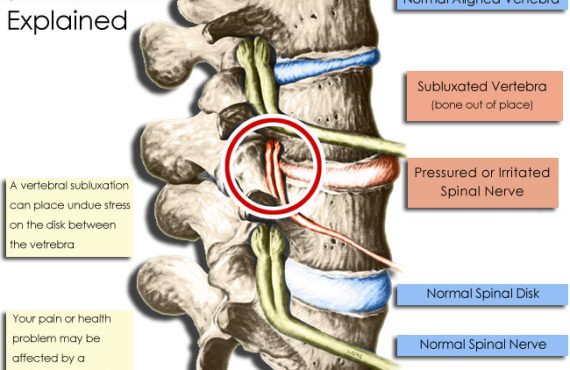Are you a senior who is experiencing back pain or discomfort? Look no further than Henry Chiropractic in Pensacola, Florida. Owned and operated by Dr. Craig Henry, a licensed chiropractor with years of experience, this clinic is dedicated to improving the health and wellness of seniors. Whether you are dealing with chronic pain or simply want to start each day feeling better, Dr. Henry and his team are here to help. With a range of techniques and a passion for helping others, they provide personalized chiropractic care that can make a real difference in your life. Don’t let pain hold you back – take the first step towards better health with chiropractic care specifically designed for seniors.

Table of Contents
Benefits of Chiropractic Care for Seniors
As you age, taking care of your health becomes even more crucial. Chiropractic care offers numerous benefits for seniors, helping them maintain a healthy and active lifestyle. Here are some of the key advantages that chiropractic care can provide to seniors:
Improved Mobility and Range of Motion
One of the primary benefits of chiropractic care for seniors is improved mobility and range of motion. As we age, our joints and muscles can become stiff and less flexible. Chiropractic adjustments help to realign the spine and other joints, promoting better joint mobility and flexibility. This can lead to increased ease of movement, making daily activities such as walking, bending, and reaching much more manageable and comfortable.
Reduced Pain and Discomfort
Senior individuals often experience chronic pain and discomfort in various parts of their bodies. Chiropractic care can help alleviate and manage this pain. By addressing misalignments in the spine and joints, chiropractors can reduce pressure on nerves and relieve pain. Chiropractic adjustments also help to reduce inflammation and improve blood flow, further reducing pain and discomfort.
Enhanced Quality of Sleep
Many seniors struggle with sleep-related issues, such as insomnia or interrupted sleep. Chiropractic care can improve the quality of sleep for seniors. By correcting misalignments in the spine, chiropractors help to relax the body and reduce tension. This can lead to better sleep patterns, allowing seniors to wake up feeling more refreshed and revitalized.
Increased Energy Levels
Chiropractic adjustments not only relieve pain but also help seniors regain their energy levels. By improving the function of the nervous system and enhancing blood circulation, chiropractic care can boost energy and vitality. Seniors often find that they have more energy to participate in their favorite activities and enjoy life to the fullest.
Improved Balance and Coordination
Maintaining good balance and coordination is essential for seniors to prevent falls and injuries. Chiropractic care can help to improve balance and coordination by addressing misalignments in the spine and joints. When the body is in proper alignment, the brain and the body can communicate more effectively, leading to better overall balance and coordination.
Specific Conditions That Chiropractic Care Can Address
Chiropractic care is effective in addressing a wide range of specific conditions that commonly affect seniors. Here are some examples of conditions that chiropractic care can help with:
Arthritis and Joint Pain
Arthritis is a prevalent condition among seniors, causing inflammation and pain in the joints. Chiropractic adjustments can help alleviate arthritis pain by reducing pressure on the affected joints. Chiropractors also provide guidance on exercises and stretches that can help improve joint function and reduce stiffness.
Osteoporosis
Osteoporosis is a condition that weakens the bones, making them more prone to fractures. While chiropractic adjustments may not be suitable for individuals with severe osteoporosis, gentle techniques can still be beneficial. Chiropractors can provide advice on exercises and lifestyle modifications that can help improve bone density and reduce the risk of fractures.
Sciatica
Sciatica is characterized by pain that radiates along the path of the sciatic nerve, which runs from the lower back down to the legs. Chiropractic care can help relieve sciatica pain by addressing the underlying cause, such as a herniated disc or spinal misalignment. Chiropractic adjustments can help alleviate pressure on the sciatic nerve, reducing pain and discomfort.
Degenerative Disc Disease
Degenerative disc disease is a condition that affects the intervertebral discs, causing them to deteriorate over time. Chiropractic care can provide relief from the pain and stiffness associated with degenerative disc disease. By realigning the spine and reducing pressure on the affected discs, chiropractic adjustments can help manage the symptoms of this condition.
Neck and Back Pain
Neck and back pain are common complaints among seniors, often caused by poor posture, spinal misalignments, or muscle imbalances. Chiropractors specialize in addressing these issues, providing adjustments and other techniques to alleviate pain and restore proper alignment. Chiropractic care can offer significant relief for seniors suffering from chronic neck and back pain.
Headaches and Migraines
Seniors also frequently experience headaches and migraines, which can significantly impact their quality of life. Chiropractic care can help relieve tension and stress in the neck and upper back, which are common triggers for headaches. By addressing spinal misalignments and promoting proper nerve function, chiropractic adjustments can provide relief from headaches and migraines.
Common Chiropractic Techniques Used for Seniors
Chiropractors use various techniques to provide safe and effective care for seniors. Here are some common chiropractic techniques used to address the needs of aging individuals:
Diversified Technique
The diversified technique is one of the most widely used methods in chiropractic care. It involves manual adjustments and thrusts to specific areas of the spine or joints to restore proper alignment. This technique is versatile and can be adapted to meet the unique needs of each senior patient.
Gonstead Spinal Manipulation
The Gonstead technique focuses on careful analysis and precision in adjusting the spine. Chiropractors using the Gonstead method make specific adjustments to the spine based on thorough examination and X-rays. This technique is especially useful for seniors with more complex spinal issues.
Instrument Assisted Soft Tissue Mobilization (IASTM)
IASTM involves the use of specialized tools to perform soft tissue mobilization. Chiropractors apply gentle and controlled pressure to affected areas, such as muscles, tendons, and fascia. This technique helps to reduce muscle tension, improve circulation, and enhance mobility.
Myofascial Release Technique (MRT)
MRT is a hands-on technique that targets myofascial restrictions in the muscles and soft tissues. By applying sustained pressure and stretching techniques, chiropractors can release tension and improve flexibility. MRT can be particularly beneficial for seniors experiencing muscle tightness or stiffness.
Low Force Adjustments
Some seniors may require low force adjustments to accommodate their specific needs. Techniques such as the Activator Method or Drop Table Technique involve the use of specialized equipment to deliver gentle and controlled adjustments. These techniques are gentle yet effective for seniors with fragile or sensitive conditions.
Flexion-Distraction Technique
The flexion-distraction technique is commonly used to treat conditions such as herniated discs and spinal stenosis. It involves a gentle, rhythmic pumping motion applied to the affected area of the spine. This technique helps to decompress the spinal discs, reduce inflammation, and relieve pain.
Precautions for Seniors Seeking Chiropractic Care
While chiropractic care is generally safe for seniors, certain precautions should be taken to ensure their well-being. Here are some important considerations for seniors seeking chiropractic care:
Medical History and Consultation
Before beginning chiropractic treatment, it is crucial for seniors to provide a thorough medical history to their chiropractor. This includes information about past surgeries, existing medical conditions, medications, and any other relevant health factors. This information allows the chiropractor to tailor the treatment plan to the individual’s specific needs.
Communication with Other Healthcare Providers
Chiropractors understand the importance of a multidisciplinary approach to healthcare. Seniors seeking chiropractic care should communicate and coordinate with their other healthcare providers, such as primary care physicians and specialists. This collaboration ensures that all aspects of their healthcare are addressed for optimal results.
Adjustments for Osteoporosis
Seniors with osteoporosis should inform their chiropractor about their condition. While chiropractic adjustments are generally safe, certain modifications may be necessary to protect fragile bones. Chiropractors can use gentler techniques and provide guidance on exercises and lifestyle modifications that promote bone health.
Gentle Techniques for Arthritis
Seniors with arthritis may require gentler chiropractic techniques to avoid exacerbating their symptoms. Chiropractors can adapt their techniques to provide effective yet gentle adjustments for individuals with arthritis. They can also recommend exercises and stretches that promote joint flexibility and reduce inflammation.
Avoiding High-Impact Adjustments
High-impact adjustments involve quick and forceful movements, which may not be suitable for seniors with certain health conditions. Chiropractors can modify their techniques to deliver low-impact adjustments that are safe and effective for seniors. It is essential for seniors to communicate any discomfort or concerns during the treatment.
Avoiding Sudden Movements
Some seniors may have difficulty with sudden or jerky movements due to muscle weakness or balance issues. Chiropractors take the individual’s physical capabilities into account and provide adjustments that accommodate their needs. Seniors should inform their chiropractor about any limitations or concerns they may have.

What to Expect During a Chiropractic Visit
Knowing what to expect during a chiropractic visit can help seniors feel more comfortable and confident in seeking care. Here is an overview of what typically happens during a chiropractic visit:
Initial Assessment and Examination
During the first visit, the chiropractor will conduct a thorough assessment and examination. This may include taking a medical history, discussing current symptoms or concerns, and performing a physical examination. The chiropractor may also request X-rays or other diagnostic tests to gather more information about the individual’s condition.
Discussion of Medical History and Concerns
The chiropractor will spend time discussing the senior’s medical history and specific concerns. This conversation helps the chiropractor gain a better understanding of the senior’s overall health and any relevant factors that may impact their chiropractic care. It is essential to provide accurate and detailed information during this discussion.
Development of a Personalized Treatment Plan
Based on the assessment, examination, and discussion, the chiropractor will develop a personalized treatment plan for the senior. This plan may include specific chiropractic adjustments, techniques, exercises, and recommendations for at-home care. The chiropractor will explain the goals of the treatment plan and answer any questions the senior may have.
Chiropractic Adjustments and Techniques
During the visit, the chiropractor will perform chiropractic adjustments and techniques as determined by the treatment plan. The chiropractor will use their hands or specialized equipment to apply controlled force to the spine or other joints, realigning them and restoring proper function. Seniors should communicate any discomfort or concerns during the adjustments.
Recommendations for At-Home Care
Chiropractors often provide recommendations for at-home care to complement the in-office treatments. This may include exercises, stretches, lifestyle modifications, or ergonomic adjustments. Following these recommendations can help seniors maintain the benefits of chiropractic care and promote overall health and well-being.
Follow-Up Visits and Progress Evaluation
Chiropractic care for seniors is typically ongoing and may require multiple visits over a period of time. The chiropractor will schedule follow-up visits to monitor the senior’s progress, make any necessary adjustments to the treatment plan, and address any new concerns that may arise. Regular follow-up visits are essential for seniors to maintain and optimize their results.
Testimonials from Seniors Who Have Benefited from Chiropractic Care
Real-life experiences from seniors who have benefited from chiropractic care can provide valuable insight into the effectiveness of this approach. Here are some testimonials from seniors who have experienced positive outcomes through chiropractic care:
John’s Story: Finding Relief from Chronic Arthritis Pain
John, a 70-year-old retiree, had been living with chronic arthritis pain for years. The discomfort in his joints made it difficult for him to enjoy activities such as walking and gardening. After several unsuccessful attempts at pain management, John decided to try chiropractic care. Through a combination of adjustments, gentle techniques, and a personalized exercise plan, John experienced significant pain relief. He regained his mobility and was able to resume his favorite activities with reduced discomfort.
Mary’s Journey: Overcoming Mobility Issues with Chiropractic Care
Mary, a 75-year-old grandmother, had been dealing with mobility issues for several years due to degenerative disc disease. Her constant back and leg pain made it challenging for her to keep up with her grandchildren. After starting chiropractic care, Mary noticed a gradual improvement in her mobility and reduction in pain. Regular adjustments and targeted exercises helped restore her range of motion, allowing her to fully participate in family activities again.
Robert’s Experience: Managing Sciatica Through Regular Adjustments
Robert, a 68-year-old retiree, had been suffering from severe sciatica pain that radiated down his leg. The pain made it difficult for him to walk, sit, or even sleep comfortably. Seeking a non-invasive option, Robert turned to chiropractic care. With a series of adjustments and specialized stretches and exercises, Robert’s sciatica pain significantly improved. He regained his mobility and was able to resume his daily activities with minimal discomfort.
Choosing a Chiropractor for Senior Care
When it comes to choosing a chiropractor for senior care, certain factors should be considered. Here are some important criteria to keep in mind:
Credentials and Qualifications
Ensure that the chiropractor you choose is licensed and has the necessary credentials and qualifications. Look for certifications and memberships in professional organizations that specialize in chiropractic care for seniors.
Experience and Specialization in Senior Care
Consider the chiropractor’s experience and specialization in providing care for seniors. Find out if they have worked with individuals in your age group and have expertise in addressing the specific conditions and concerns that seniors may have.
Positive Reviews and Patient Testimonials
Read reviews and testimonials from other seniors who have received care from the chiropractor you are considering. Positive feedback and testimonials can provide valuable insights into the effectiveness and quality of care that the chiropractor provides.
Accessibility and Location
Consider the location and accessibility of the chiropractic clinic. It should be easily accessible for seniors, with considerations given to parking, transportation, and any mobility limitations. The proximity of the clinic to the senior’s residence can also be a factor to consider.
Communication and Personalized Care Approach
Choose a chiropractor who demonstrates excellent communication skills and takes the time to listen to your concerns. A personalized care approach that addresses your specific needs and preferences is essential for a positive experience and optimal outcomes.
Insurance Coverage and Payment Options
Check if the chiropractor accepts your insurance coverage and offers convenient payment options. This ensures that you can receive the care you need without significant financial burdens.
Frequently Asked Questions about Chiropractic Care for Seniors
Here are some frequently asked questions about chiropractic care for seniors, along with brief answers:
Is chiropractic care safe for seniors?
Yes, chiropractic care is generally safe for seniors. With proper assessment and adjustments tailored to their specific needs, chiropractic care can provide safe and effective treatment for seniors.
How many chiropractic sessions are usually needed?
The number of chiropractic sessions required varies depending on the individual’s condition, response to treatment, and overall goals. Seniors may need multiple sessions over a period of time to achieve and maintain optimal results.
Can chiropractic care help with balance and fall prevention?
Yes, chiropractic care can help with balance and fall prevention by addressing spinal misalignments and improving overall alignment and function. Improved balance and coordination can help seniors avoid falls and maintain their independence.
Are there any age restrictions for chiropractic care?
There are no strict age restrictions for chiropractic care. Chiropractors can adapt their techniques to accommodate individuals of all ages, including seniors.
Can chiropractic care improve overall well-being in seniors?
Yes, chiropractic care can improve overall well-being in seniors. By addressing spinal misalignments and promoting proper nerve function, chiropractic adjustments can enhance the body’s natural healing abilities and support overall health.
Are there any side effects or risks associated with chiropractic adjustments?
While chiropractic adjustments are generally safe, some individuals may experience mild soreness or discomfort following an adjustment. Serious complications are rare but can occur. Seniors should communicate any concerns or discomfort to their chiropractor during the treatment process.
Conclusion
Chiropractic care offers a wide range of benefits for seniors, including improved mobility, reduced pain, enhanced sleep quality, increased energy levels, and improved balance and coordination. By addressing specific conditions such as arthritis, osteoporosis, sciatica, degenerative disc disease, neck and back pain, and headaches, chiropractic care provides targeted relief for seniors. By utilizing various chiropractic techniques and taking precautions such as considering medical history, communicating with other healthcare providers, and using gentle techniques, seniors can safely and effectively seek chiropractic care. Through personalized treatment plans, chiropractic adjustments, and at-home care recommendations, seniors can experience significant improvements in their health and well-being. Choosing a qualified chiropractor who specializes in senior care and considering factors such as qualifications, experience, reviews, accessibility, and payment options is important for seniors seeking chiropractic care. By addressing frequently asked questions and providing real testimonials from seniors who have benefited from chiropractic care, this article aims to inform and empower seniors to take the first step towards improved health and wellness through chiropractic care.




































































































































